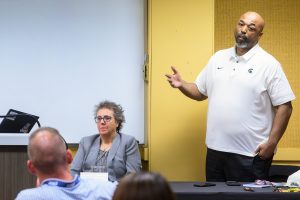Over two hundred educators, mental health professionals, law enforcement officials, community organizers, and policy officials traveled to the beautiful campus of Michigan State University for Prevent 2 Protect’s 2025 Adolescent Targeted Violence Prevention Conference on September 8 and 9. Not only did this conference highlight our groundbreaking, one-of-a-kind, cross-systems intervention focused on stopping targeted school violence before it happens, but attendees learned from leading national experts in threat assessment, mental health, and school safety.
 “[It] all was helpful!” said Jamie Eathorne, a school health consultant with Wayne Regional Educational Service Agency. “[I’m looking forward] to hearing updates on the [Prevent 2 Protect] pilot as it gets closer to phase 2.”
“[It] all was helpful!” said Jamie Eathorne, a school health consultant with Wayne Regional Educational Service Agency. “[I’m looking forward] to hearing updates on the [Prevent 2 Protect] pilot as it gets closer to phase 2.”
In addition to featuring national experts Dr. Peter Langman, Dr. Jessica Stern, Dr. Melissa Reeves, and Dr. Alexander Westphal, the Prevent 2 Protect team offered four breakout sessions. Briding Safety and Support: Insights into Behavioral Threat Assessment, lead by Danielle Murphy, Mary Gebara, and Noah Petzak, covered key insights into the new education policy regarding Behavioral Threat Assessment and Management (BTAM), including case examples, new legislation impacting school safety, and current trends. The Education Policy Team highlighted implementation challenges, referral patterns, and best practices based on Prevent 2 Protect observations.
The Mental Health Team, made up of Dr. Ley, Martine Highet, and Megan Goldstein, guided the breakout session ACEs, Generational Trauma, and Mental Health: Pathways to Intervention. The team explored the impact of adverse childhood experiences (ACEs) and untreated psychiatric conditions on child outcomes. The examined the connection between psychiatric condidtions and targeted violence, emphasizing the medical urgeny of suicidal and homicial ideation (SI/HI) and barriers to treatment. The discussion included Prevent 2 Protect findings on ACEs, generational trauma, diagnoses, treatment compliance, and outcomes.
untreated psychiatric conditions on child outcomes. The examined the connection between psychiatric condidtions and targeted violence, emphasizing the medical urgeny of suicidal and homicial ideation (SI/HI) and barriers to treatment. The discussion included Prevent 2 Protect findings on ACEs, generational trauma, diagnoses, treatment compliance, and outcomes.
United Fronts: Collaborative Paths to Preventing Targeted Violence was taught by the Law Enforcement Team – Ellery Sosebee, Traci Austin, and Jay Greene. The team presented a case example highlighting the need for community collaboration and standardized approaches among school BTAM, law enforcement, and prosecutors in addressing targeted violence threats. It reviews data on threat nature, weapon access, and legal outcomes from Prevent 2 Protect participants, with comparisons to NTAC findings. The session also covered identifying credible threats and best practices for timely, effective follow-up.
Syriah Dobis, Adam Royer, and Robert Clark, the Education Team, lead Unseen Struggles: Nurturing Hope Through Early Education Supports. They reviewed case examples illustrating how unmet educational needs can impact students’ self-esteeem and lead to grievances against schools. Prevent 2 Protect findings on the prevalence of IEPs, 504 plans, and early intervention designations, highlighting barriers like truancy and explusion that hinder timely assessment were also examined. The session highlighted the vital importance of early detection and timely intervention in special education to effectively address root challenges.

Attendees had the opportunity to listen and ask questions to Prevent 2 Protect’s regional case managers and mentors during theirrespective panels. Law Enforcement Liaison Ellery Sosebee moderated Community Conversations: Building Bridges Between Mental Health and Law Enforcement, a panel featuring Kevin Fischer, NAMI Michigan & Crisis Intervention Team (CIT) International Michigan Executive Director, and Pastor Terrence King, Chief Servant Officer and Co-Founder of Kingdom Ministries.
By offering multiple breakout sessions and a variety of panels and keynote speakers, attendees gained valuable tools and knowledge to help indentify, assess, and intervene early before a crisis turns into tragedy.
By: Lieza Klemm
